Very Large Historic Cochiti Pueblo Storage Jar - 26063
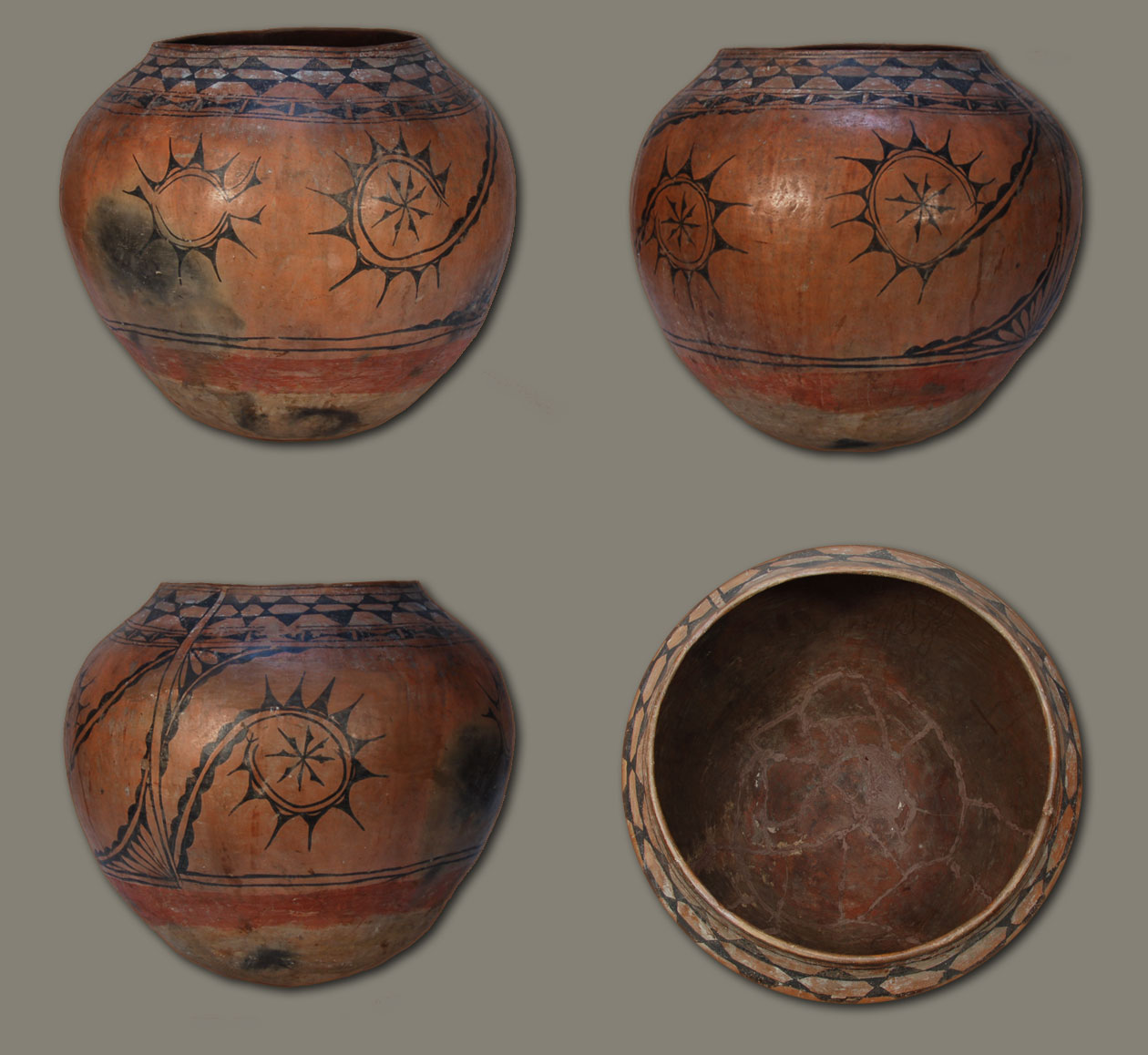 he historic period of pueblo pottery has been defined as beginning with the first contact with Europeans in 1540, the reasoning being that it was the Europeans who began documenting events, creating a history of the area, which was a logical beginning of the historic pottery period. At that time, pueblo potters made pottery for their own use and as a trade item to members of other pueblos or tribes.
he historic period of pueblo pottery has been defined as beginning with the first contact with Europeans in 1540, the reasoning being that it was the Europeans who began documenting events, creating a history of the area, which was a logical beginning of the historic pottery period. At that time, pueblo potters made pottery for their own use and as a trade item to members of other pueblos or tribes.
With the arrival of the Spanish, the market for pueblo pottery greatly increased as it was easier and smarter to procure pottery from local pueblo potters than to wait for imports to arrive on the Camino Real from Mexico City, a journey that took over 6 months to complete. New shapes and new sizes of pottery were developed to satisfy the needs of the new markets. Large storage jars were standard measurements of volume to facilitate trade of wheat or grains to the market. In some cases, the historic jar in which the grain was stored was given with the sale of the grain as it was considered only a container of the product being sold. One wonders if the purchaser of a jar full of grain used the product then discarded the container.
#adobegallery #SouthwestIndianPottery #cochitiPottery #PuebloPottery #SouthwestIndianArt #SantaFePottery #FinePuebloPottery #VisitCanyonRoad #HistoricPottery
Circa 1950, Hopi Pueblo Sio Salako Katsina Doll - C4050E
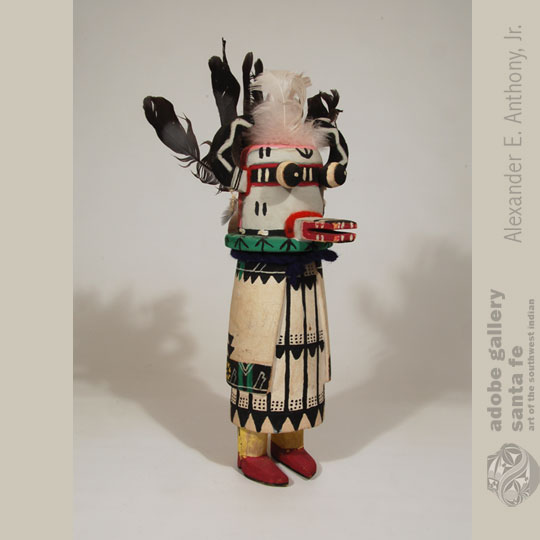 "The Sio Salako is a Hopi interpretation of the Shalako Ceremony of Zuni and thus receives the name Sio (Zuni). Sio Salako is portrayed like neither the Zuni nor the Hopi Salako but is instead a separate entity. He was introduced to the Hopis by a Tewa man around 1850 and first appeared as a group of four kachinas. Since that time changes in ceremonial have reduced the number to one and added Salako Manathat formerly did not appear.
"The Sio Salako is a Hopi interpretation of the Shalako Ceremony of Zuni and thus receives the name Sio (Zuni). Sio Salako is portrayed like neither the Zuni nor the Hopi Salako but is instead a separate entity. He was introduced to the Hopis by a Tewa man around 1850 and first appeared as a group of four kachinas. Since that time changes in ceremonial have reduced the number to one and added Salako Manathat formerly did not appear.
"He appears in late spring on very rare occasions and is thought to be especially efficacious in bringing rain. A view of this nine-foot kachina is a rare sight indeed." Wright 1973
The basic difference in costume of the Zuni Shalako Katsina and the Hopi Sio SalakoKatsina is in body dress. Zuni Shalako are clothed in a white manta below the embroidered shoulder wrap. The Sio Salako at Hopi retains the Hopi style of feathers covering the body. The shoulder wrap is the same style as that at Zuni. The difference between the male and female version of the Sio Salako is that the male wears traditional moccasins and the female wears the white doe skin moccasins with leg wraps.
#adobegallery #HopiPueblo #Katsina #Kachina #SioSalako #Doll #SouthwestIndianArt #PuebloArt #SantaFeNM
Teec Nos Pos Regional Navajo Rug - C3969A
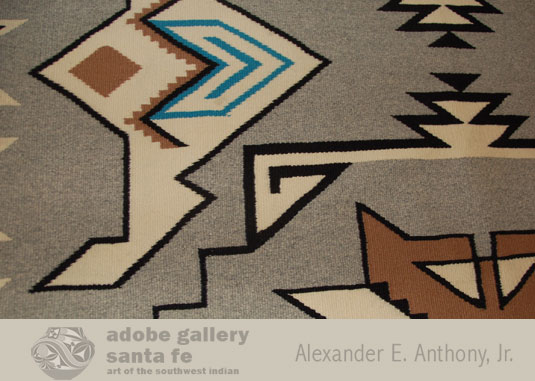 Navajo rugs from the Teec Nos Pos area of the Navajo Reservation are considered the most beautiful designed rugs of all and, at the same time, considered the least Navajo of all. The designs have been influenced by early traders at the trading post providing designs of Persian rugs to the weavers and, in one instance, painting such designs on the exterior walls of the trading post in the hopes that the weavers would copy those designs.
Navajo rugs from the Teec Nos Pos area of the Navajo Reservation are considered the most beautiful designed rugs of all and, at the same time, considered the least Navajo of all. The designs have been influenced by early traders at the trading post providing designs of Persian rugs to the weavers and, in one instance, painting such designs on the exterior walls of the trading post in the hopes that the weavers would copy those designs.
Teec Nos Pos (circle of cottonwoods) Trading Post was established in 1905 by Hambleton (Hamp) Bridger Noel, the first white man who was able to win the approval of the local Navajo to set up a trading post on their land. Ten years earlier, two potential traders were driven off. Hamp Noel married Eva Foutz in 1911 and eventually the Foutz family took over the post and still operate it today.
Teec Nos Pos rugs generally have large geometric figures arranged on a central rectangular plane. Before the 1940s, almost all the wool used for warp and weft was handspun and hand dyed. After World War II, the weavers began to use commercial 4-ply wool and then 3-ply Germantown wool in small amounts as filler elements. The trading post stocked these commercial yarns in vibrant colors desired by the weavers.
This Navajo textile follows the traditions of Teec Nos Pos in design and use of many colors. The center field is comprised of a commercial yarn grey background. There are three main design elements down the center of the textile and two triangular design elements on either side. Each of the three central elements is enclosed in an outline black stepped design. Yarn colors of brown, black, turquoise, red and white are used as accent designs.
#adobegallery #Navajo #Textiles #Blankets #Rugs #Diné #TeecNosPos #NavajoRugs #SouthwestIndianTextiles #SantaFeNM #TheCityDifferent
Hopi Pueblo Elaborately Designed Polychrome Jar by Rondina Huma - C4052F
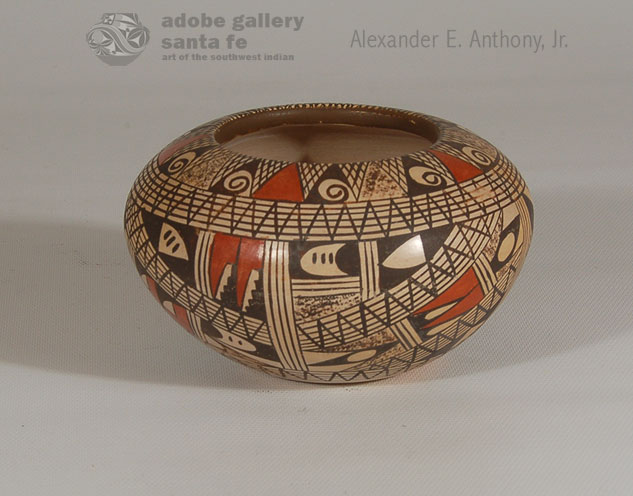 Rondina Huma's intricately designed pottery has been one of the most sought-after for over a decade. She has been featured in many publications and her work is represented in major galleries and museums throughout the country. There is no mystery as to why she has won many awards over the years for her exquisite work. She deserves every accolade bestowed on her. Her pottery is traditional in every manner. She hand coils all the vessels and uses only vegetal and mineral paints. Traditional firing is carried out as well. It is reported that she no longer can make pottery due to sight problems, a great loss to collectors.
Rondina Huma's intricately designed pottery has been one of the most sought-after for over a decade. She has been featured in many publications and her work is represented in major galleries and museums throughout the country. There is no mystery as to why she has won many awards over the years for her exquisite work. She deserves every accolade bestowed on her. Her pottery is traditional in every manner. She hand coils all the vessels and uses only vegetal and mineral paints. Traditional firing is carried out as well. It is reported that she no longer can make pottery due to sight problems, a great loss to collectors.
This small jar is as magnificent as her larger works. It is filled with designs throughout its entire surface.
![]()
#adobegallery #SouthwestIndianPottery #SanIldefonsoPueblo #PuebloPottery #SantaFePottery #FinePuebloPottery #SantaFeNM #ContemporaryPottery #RondinaHuma
Hand Blown Replica of a Historic Acoma Olla - Mesa Pot - C4055i
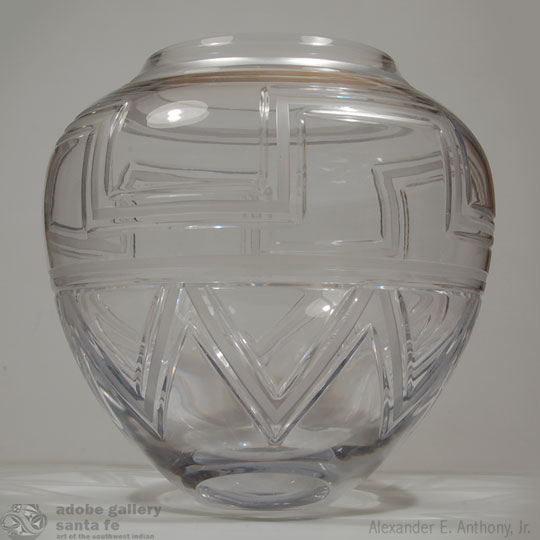 In the early 2000s, Nambe Mills of Santa Fe collaborated with the Museum of Indian Arts and Culture to create a limited edition of hand-blown crystal pottery vessels inspired by pieces in the museum's collection. Nambe Mills selected Rogaska Crystals of Croatia, to perform the hand-blown process to make the jars.
In the early 2000s, Nambe Mills of Santa Fe collaborated with the Museum of Indian Arts and Culture to create a limited edition of hand-blown crystal pottery vessels inspired by pieces in the museum's collection. Nambe Mills selected Rogaska Crystals of Croatia, to perform the hand-blown process to make the jars.
Nambe and Rogaska produced glass replicas of five different pueblo jars. According to Nambe staff, there were approximately 1000 hand-blown glass replicas of each historic jar.
#adobegallery #SouthwestIndianPottery #AcomaPueblo #PuebloPottery #SantaFePottery #FinePuebloPottery #SantaFeNM
Very Large Historic Acoma Pueblo Olla - C3969K
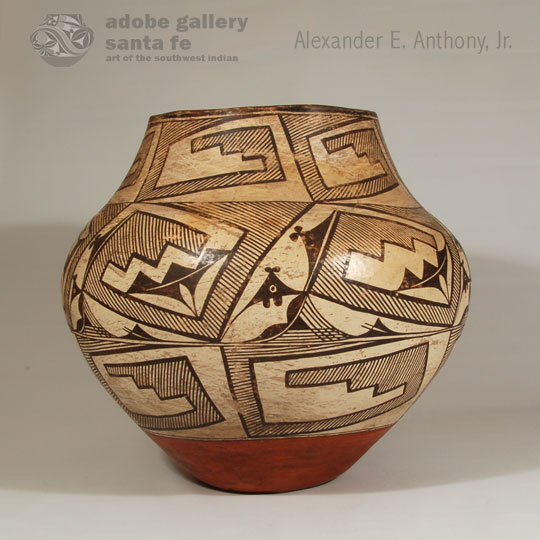 Early Acoma Black-on-white ollas generally have bold designs such as seen on this jar. The mid-body design features canted rectangles comprised of bars filled with black parallel fine lines. There are three horizontal bands with these elements-neck, mid-body and lower body. Jars with bounded hachure lines like these became very common after 1890. Harlow & Lanmon p.158
Early Acoma Black-on-white ollas generally have bold designs such as seen on this jar. The mid-body design features canted rectangles comprised of bars filled with black parallel fine lines. There are three horizontal bands with these elements-neck, mid-body and lower body. Jars with bounded hachure lines like these became very common after 1890. Harlow & Lanmon p.158
Complimentary with the bounded hachure designs are black triangles, triangular caps with paired ears, some of which have an eye in the middle. Those elements are limited to only the center band of design. This design facilitates dating this jar to circa 1900.
#adobegallery #SouthwestIndianPottery #AcomaPueblo #PuebloPottery #SantaFePottery #FinePuebloPottery #SantaFeNM #HistoricPottery
Historic Acoma Pueblo Very Large Black-on-white Wedding Vessel - C3969J
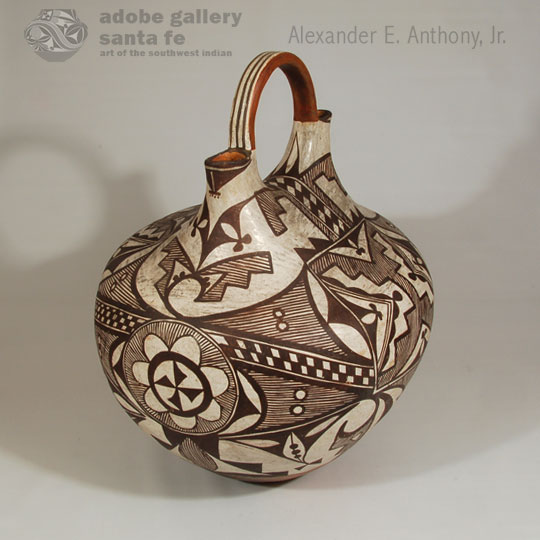 Although the wedding vessel has prehistoric precedents, it does not seem to have been made at Acoma Pueblo prior to 1900. The very comprehensive 623-page book on Acoma Pueblo pottery by Harlow and Lanmon does not display a single wedding vessel. Historic photographs reproduced in that book do not show wedding vessels either. Rick Dillingham, in his book on Acoma pottery, hints at the impetus for potters making wedding vessels as probably dealers, who saw a market for something that could be explained as a ceremonial item used in weddings. Double-spouted prehistoric and pre-Columbian vessels are not referred to as wedding vessels. Most likely, we can credit Santa Fe merchants for influencing the creation of today's wedding vessels.
Although the wedding vessel has prehistoric precedents, it does not seem to have been made at Acoma Pueblo prior to 1900. The very comprehensive 623-page book on Acoma Pueblo pottery by Harlow and Lanmon does not display a single wedding vessel. Historic photographs reproduced in that book do not show wedding vessels either. Rick Dillingham, in his book on Acoma pottery, hints at the impetus for potters making wedding vessels as probably dealers, who saw a market for something that could be explained as a ceremonial item used in weddings. Double-spouted prehistoric and pre-Columbian vessels are not referred to as wedding vessels. Most likely, we can credit Santa Fe merchants for influencing the creation of today's wedding vessels.
#adobegallery #SouthwestIndianPottery #AcomaPueblo #PuebloPottery #SantaFePottery #FinePuebloPottery #SantaFeNM #HistoricPottery
Original Painting Titled “Navajo Archer” by Adee Dodge - C4056N
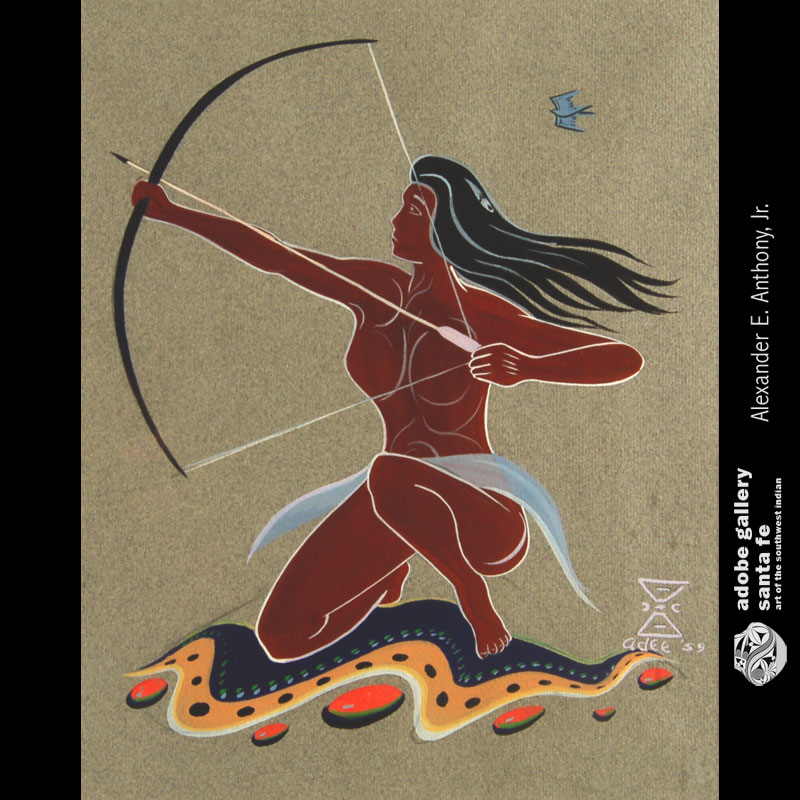 Adee Dodge was the grandson of the first Navajo Tribal Chairman, Chee Dodge. He studied at the University of New Mexico and received a master's degree from Columbia University in Comparative Linguistics and Anthropology. He started painting while recovering from war wounds he received while serving in the South Pacific during World War II. A self-taught painter, he focused his work on preserving the symbols and stories of the Navajo religion. His work has been featured in Arizona Highways and at the Smithsonian.
Adee Dodge was the grandson of the first Navajo Tribal Chairman, Chee Dodge. He studied at the University of New Mexico and received a master's degree from Columbia University in Comparative Linguistics and Anthropology. He started painting while recovering from war wounds he received while serving in the South Pacific during World War II. A self-taught painter, he focused his work on preserving the symbols and stories of the Navajo religion. His work has been featured in Arizona Highways and at the Smithsonian.
This painting is of a single figure female archer with bow taut and arrow ready to release. Dodge had a time where his paintings reflect influence of the Art Decoperiod. It is quite apparent in this painting. The archer appears to be nude with long flowing black hair. She is kneeling on an abstract and colorful design. It is signed in lower right and dated 1959.
#adobegallery #SouthwestIndianPainting #NativeAmericanPainting # Navajo #PuebloPaintings #SantaFeNM #FineArt #Painting # AdeeDodge
Southwest Painting of Four Deer Dancers by Harry Fonseca - C4056C
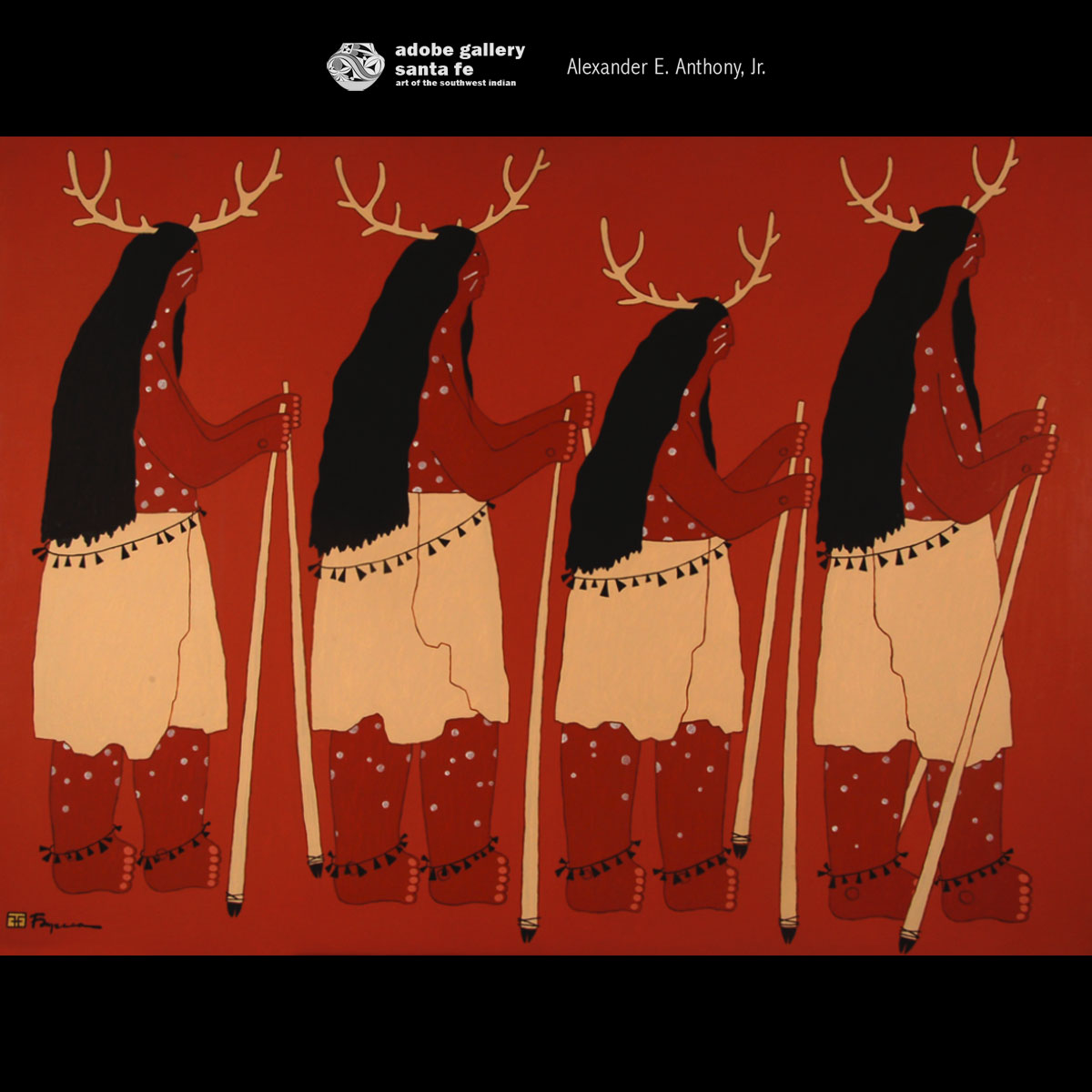 This painting is part of Fonseca's exploration of his Maidu heritage. This was before he moved to New Mexico; and this work pre-dates his New Mexico life. Beginning in the early 1970s he began learning more about his Nisenan (Southern Maidu) heritage by attending dances, participating in dances, learning from Maidu elders and doing his own research. Bernstein
This painting is part of Fonseca's exploration of his Maidu heritage. This was before he moved to New Mexico; and this work pre-dates his New Mexico life. Beginning in the early 1970s he began learning more about his Nisenan (Southern Maidu) heritage by attending dances, participating in dances, learning from Maidu elders and doing his own research. Bernstein
This is a painting of four men participating in a Deer Dance ceremony. In New Mexico pueblo culture, such a dance is a plea to the spirit of the deer to make himself available for the people in need of food. It also is then performed as a thank you to the deer for having done so. It is quite possible that a similar ceremony is performed by the Maidu culture.
#adobegallery #SouthwestIndianPainting #NativeAmericanPainting # Maidu #PuebloPaintings #SantaFeNM #FineArt #Painting #HarryFonseca
Apache Artist Frank Paul Vigil's Painting of Two Horses - C4056F
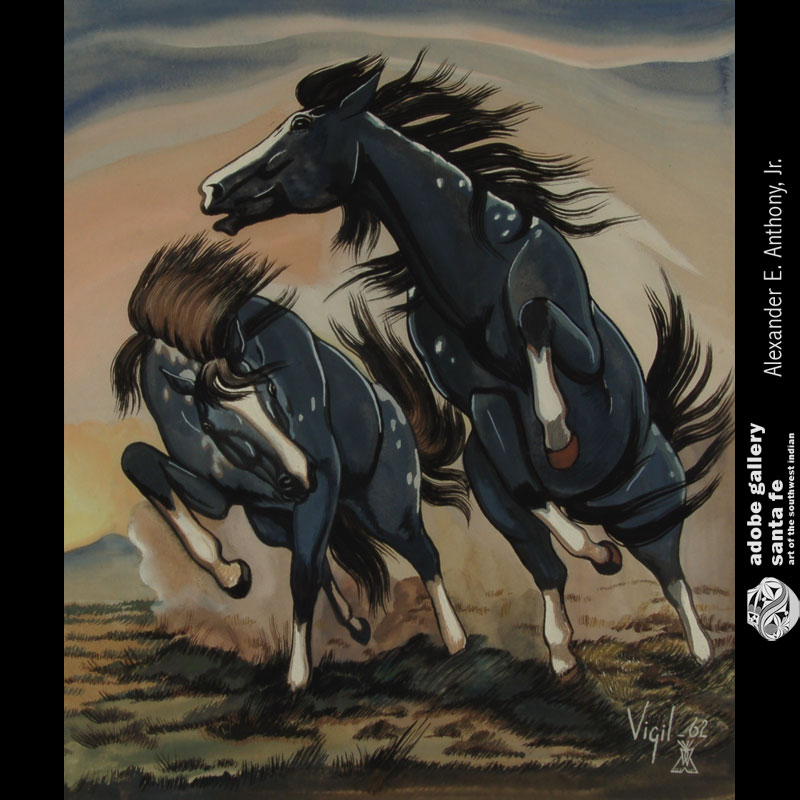 Frank Paul Vigil was born in 1922 on the Jicarilla Apache reservation which is located in Northwestern New Mexico. He grew up surrounded by animals, both domestic and wild. As a child he was fascinated by these animals and began to draw them as he saw them, in active motion as well as at rest. He was a self-taught artist who drew the animals around him that were important to him--horses, elk and deer. He was a hunter and an outdoorsman and his paintings reflect his intimate knowledge of animals.
Frank Paul Vigil was born in 1922 on the Jicarilla Apache reservation which is located in Northwestern New Mexico. He grew up surrounded by animals, both domestic and wild. As a child he was fascinated by these animals and began to draw them as he saw them, in active motion as well as at rest. He was a self-taught artist who drew the animals around him that were important to him--horses, elk and deer. He was a hunter and an outdoorsman and his paintings reflect his intimate knowledge of animals.
As an adult, Vigil married a Jemez woman and lived at her Pueblo. He served in the US Army during World War II. His artwork has been exhibited widely at the Gallup Intertribal Ceremonials, and the Philbrook in Tulsa, Oklahoma. He was best known for his paintings of traditional Apache images such as Crown Dancers as well as his action filled depictions of galloping horses.
#adobegallery #SouthwestIndianPainting #NativeAmericanPainting #Jicarilla #Apache #PuebloPaintings #SantaFeNM #FineArt #Painting #FrankVigil
Painting of Very Large San Ildefonso Pueblo Dance Scenes by Soqween - C4059.16
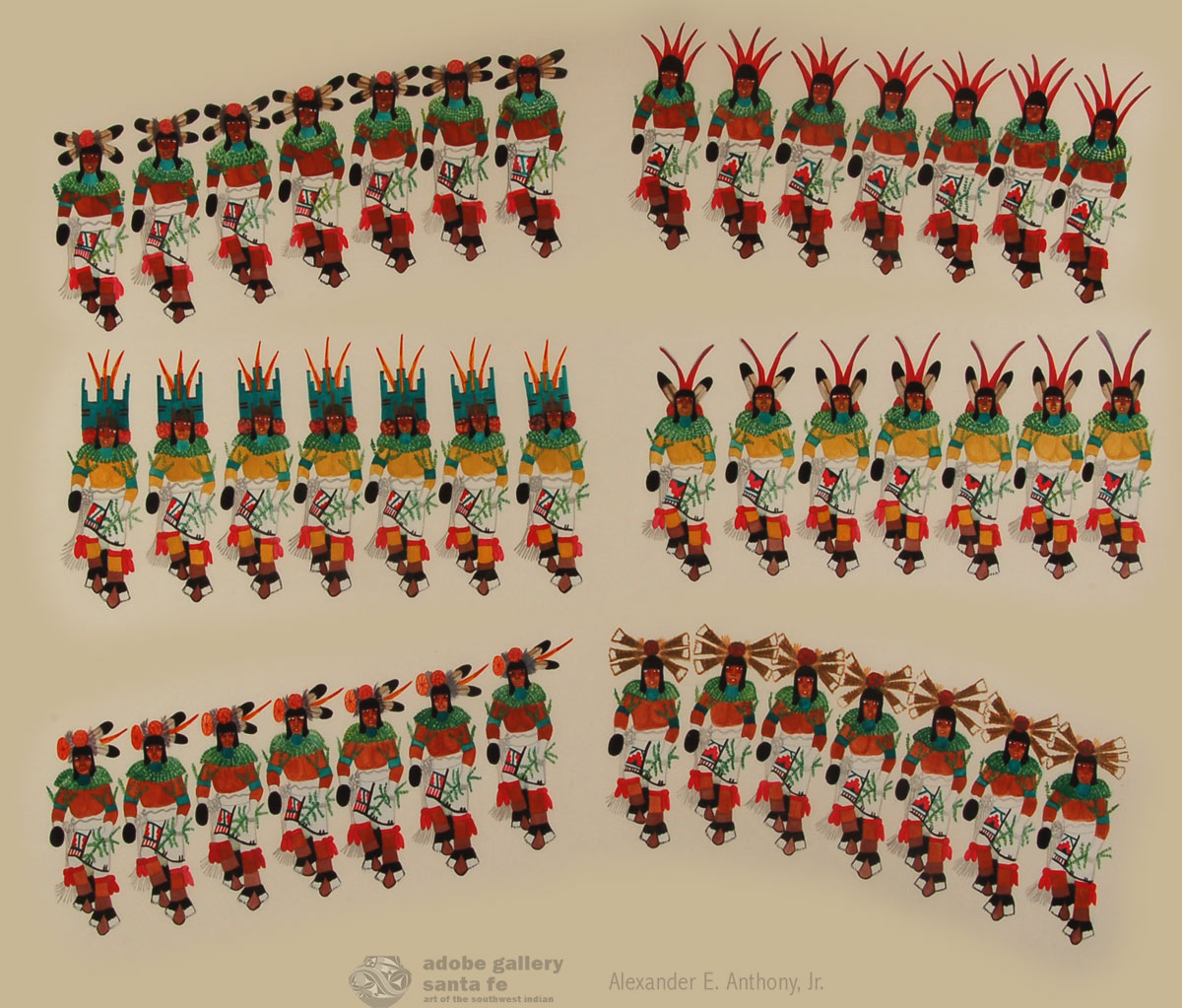 Peña was painting at San Ildefonso Pueblo at the same time as Tonita Peña, Ricahard Martínez, Luís Gonzales, Abel Sánchez, and Romando Vigil. In his early years, he was not as prolific as his peers. It was during the last ten years of his life that he became productive. He is represented in the collections of the Laboratory of Anthropology, Santa Fe; Museum of New Mexico; Denver Art Museum; and many others.
Peña was painting at San Ildefonso Pueblo at the same time as Tonita Peña, Ricahard Martínez, Luís Gonzales, Abel Sánchez, and Romando Vigil. In his early years, he was not as prolific as his peers. It was during the last ten years of his life that he became productive. He is represented in the collections of the Laboratory of Anthropology, Santa Fe; Museum of New Mexico; Denver Art Museum; and many others.
Though similar in spirit, Soqween's works are very different from those of his contemporaries. His works are simple, often using just two or three colors. His outlines, often done in light grey, are less important to his compositions than the thick blocks of bold colors with which they are filled. These blocks of color are the tools with which he composed his subjects: Pueblo dancers, in traditional regalia, often viewed head-on instead of in profile. Soqween's style is a simple, charming, and unusual variation of the "flat" style that he and his peers were taught at the Santa Fe Indian School.
#adobegallery #SouthwestIndianPainting #NativeAmericanPainting #SanIldefonsoPueblo #PuebloPaintings #SantaFeNM #FineArt #Painting #JoseEncarnacionPena #Soqween
Southwest Indian Painting of Navajo Men on Horseback by Narciso Abeyta - C4059.15
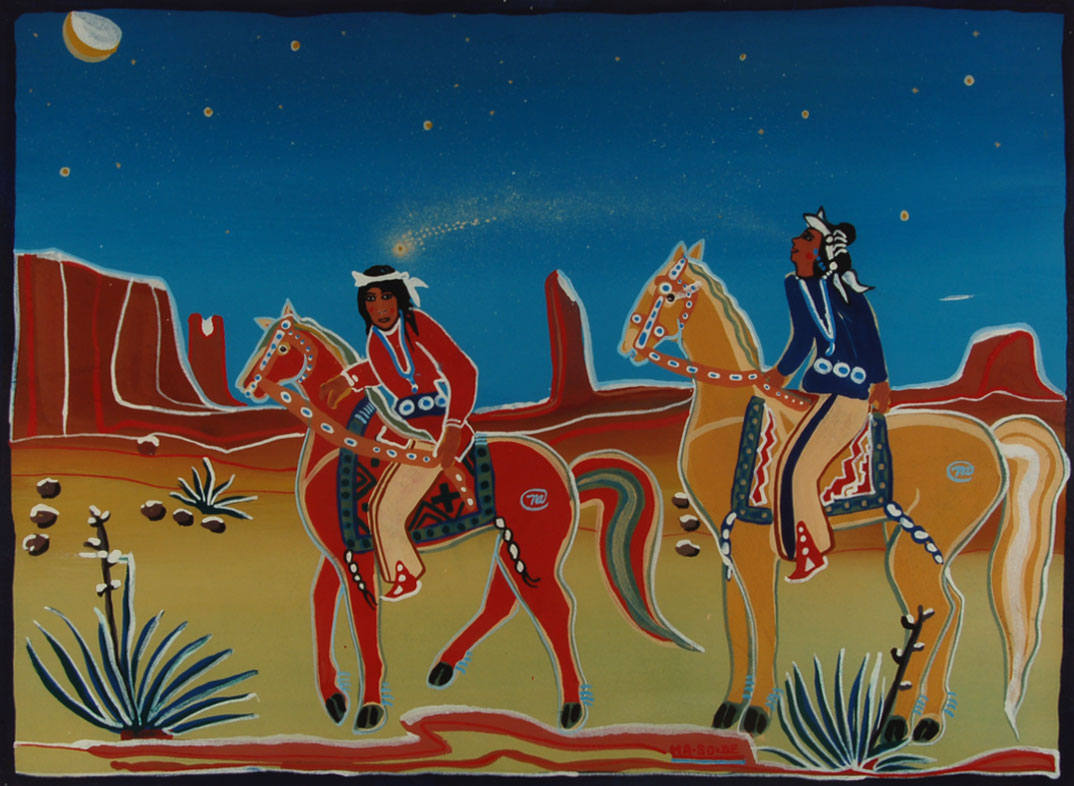 Narciso Platero Abeyta (1918-1998) Ha So De was a Navajo painter and silversmith. He was, among other things, a Golden Gloves boxer and one of the hundreds of Navajo Code Talkers who served in the Marines during World War II. Abeyta and wife Sylvia Ann had seven children, many of whom-Tony Abeyta, Elizabeth Abeyta Rohrscheib and Pablita Abeyta-became notable artists themselves.
Narciso Platero Abeyta (1918-1998) Ha So De was a Navajo painter and silversmith. He was, among other things, a Golden Gloves boxer and one of the hundreds of Navajo Code Talkers who served in the Marines during World War II. Abeyta and wife Sylvia Ann had seven children, many of whom-Tony Abeyta, Elizabeth Abeyta Rohrscheib and Pablita Abeyta-became notable artists themselves.
Abeyta was educated at the Santa Fe Indian School by Dorothy Dunn, who commented on his abilities in her book American Indian Painting of the Southwest and Plains Areas: "Ha-So-De developed a markedly unique style, although, in his formative period, his admiration for the work of (Navajo painter Andy) Tsinhnahjinnie could be clearly seen. It was a fine influence and used honorably by the younger painter. His paintings of hunt and home scenes were broad in brushwork and flowing in line, at times appearing almost nonchalant. He was never concerned with small detail but only with the sweep and dash of movement in wild, free scenes. His was a positive art."
#adobegallery #SouthwestIndianPainting #NativeAmericanPainting #Navajo #PuebloPaintings #SantaFeNM #FineArt #Painting #NarcisoAbeyta
Hopi Pueblo Polychrome Jar with Katsina Imagery by Fannie Nampeyo - C4051A
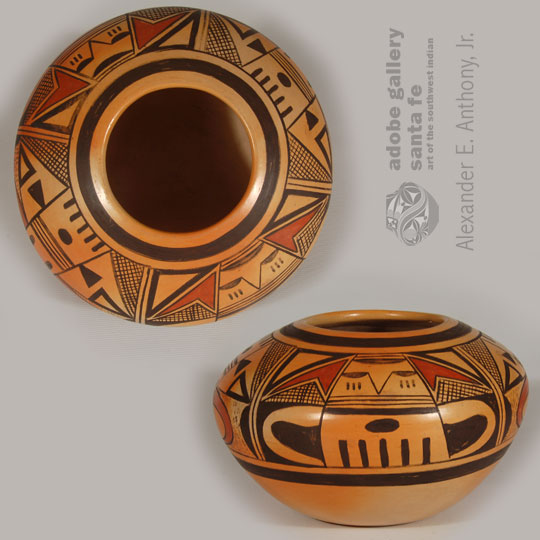 Nampeyo of Hano was probably the first Hopi-Tewa potter to paint Katsina imagery on 20th century pottery. It is not unexpected, then, that her daughter, Fannie, would follow her mom's tradition. Fannie Polacca Nampeyo (1900-1987) was one of three daughters of Nampeyo and Lesou and the last of the three to pass away. It is for this reason that most collectors are familiar with her as she was actively making pottery in the mid- 20th century during the increase in popularity of Native American Pottery by collectors.
Nampeyo of Hano was probably the first Hopi-Tewa potter to paint Katsina imagery on 20th century pottery. It is not unexpected, then, that her daughter, Fannie, would follow her mom's tradition. Fannie Polacca Nampeyo (1900-1987) was one of three daughters of Nampeyo and Lesou and the last of the three to pass away. It is for this reason that most collectors are familiar with her as she was actively making pottery in the mid- 20th century during the increase in popularity of Native American Pottery by collectors.
The imagery on this jar appears to be the face of a katsina. The five vertical lines at the bottom of the face probably represent a beard like that of the Long Hair Katsina. The parallel lines under the eyes could represent warrior marks. Probably, it is not a specific katsina, but meant to represent the medium.
#adobegallery #SouthwestIndianPottery #HopiPueblo #PuebloPottery #SouthwestIndianArt #SantaFePottery #FinePuebloPottery # FannieNampeyo #VisitCanyonRoad
Hopi Pueblo Tall Polychrome Cylindrical Jar by Joy Navasie - C4052A
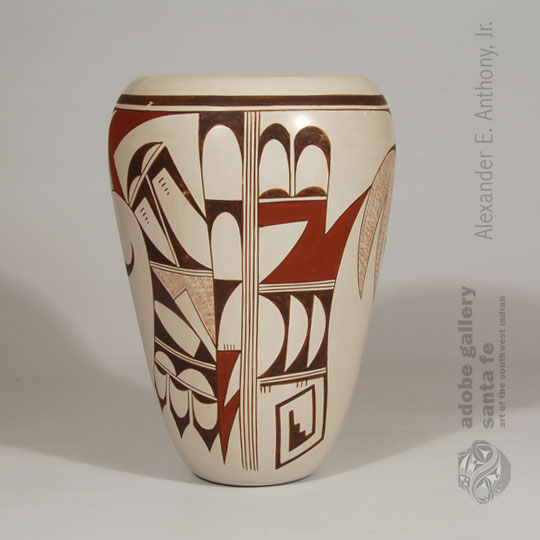 Joy Navasie (1919 - 2012) second Frog Woman - Yellow Flower was one of the finest Hopi-Tewa potters and her skill in crafting this vase is evident. The precise symmetry of the jar is enhanced by the beautiful design elements. The vase is separated into halves with the elements on opposite sides mirroring each other. The painting was applied with an expert hand. The subtle combination of rust red and brown on a fine creamy white slip is striking. This is a piece that illustrates just why Frog Woman was recognized as one of the finest Hopi-Tewa potters of the 20th century.
Joy Navasie (1919 - 2012) second Frog Woman - Yellow Flower was one of the finest Hopi-Tewa potters and her skill in crafting this vase is evident. The precise symmetry of the jar is enhanced by the beautiful design elements. The vase is separated into halves with the elements on opposite sides mirroring each other. The painting was applied with an expert hand. The subtle combination of rust red and brown on a fine creamy white slip is striking. This is a piece that illustrates just why Frog Woman was recognized as one of the finest Hopi-Tewa potters of the 20th century.
Each design is comprised of two parts which are separated by five parallel vertical lines. To the left of the design is a stylized parrot inspired by the Hopi prehistoric Sikyatki pottery. To the right of the lines is a stacked design of four sections, the lower one being a hooked element, above which are three geometric elements. The design is repeated on the opposite side.
#adobegallery #SouthwestIndianPottery #HopiPueblo #PuebloPottery #SouthwestIndianArt #SantaFePottery #FinePuebloPottery # JoyNavasie #VisitCanyonRoad
Acoma Pueblo Jar with Heartline Deer by Marie Chino - C4052D
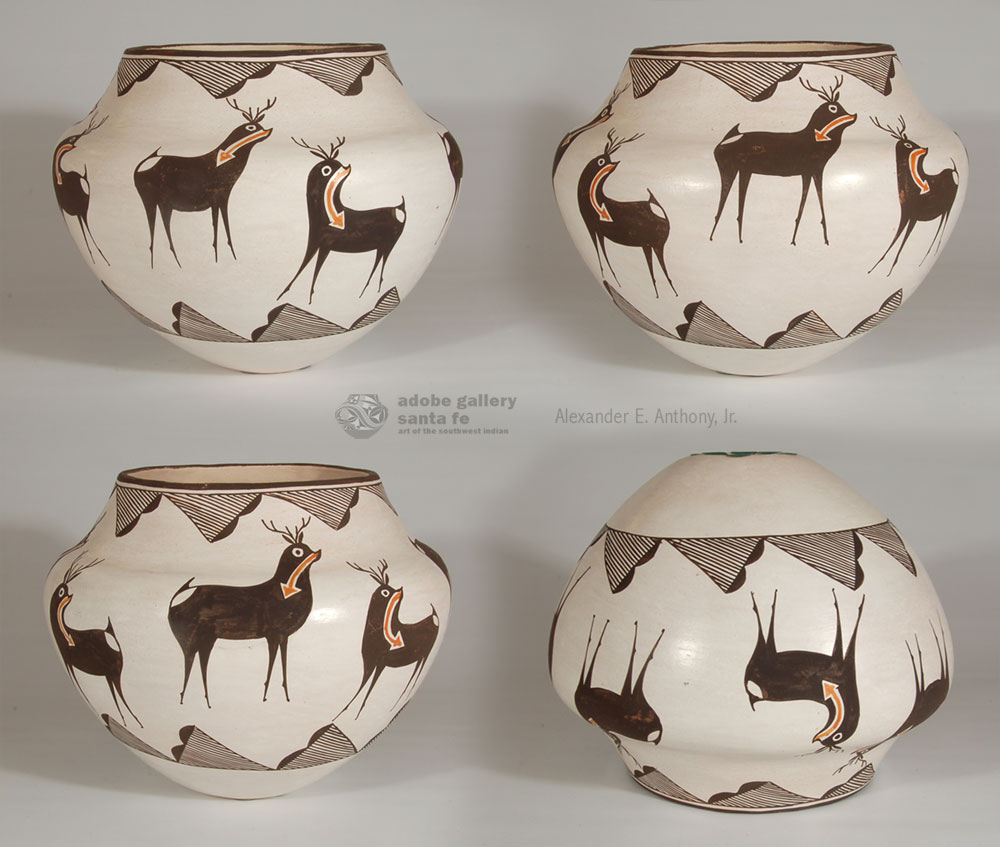 Much praise has been bestowed on Marie Z. Chino for the magnificent pottery she made in the fifty years she devoted to the craft and the praise is certainly earned. Chino was a master potter and it is understandable why collectors admire her work so enthusiastically. She was certainly one of the Acoma potters who made particularly important contributions to the art of pottery making in the period following World War II. Chino was making Southwest Indian pottery as early as the 1920s.
Much praise has been bestowed on Marie Z. Chino for the magnificent pottery she made in the fifty years she devoted to the craft and the praise is certainly earned. Chino was a master potter and it is understandable why collectors admire her work so enthusiastically. She was certainly one of the Acoma potters who made particularly important contributions to the art of pottery making in the period following World War II. Chino was making Southwest Indian pottery as early as the 1920s.
Chino is considered one of the significant ceramicists at Acoma and was the matriarch of a very talented family of potters. She is best known for her black-on-white pottery. Along with Lucy Lewis and Sarah Garcia she led the revival of the ancient pottery forms of the ancestral pueblo potters. She was one of the women who was inspirational in the movement to revive the use of ancient Mimbres designs on contemporary Acoma pottery.
It has been stated that Lucy Lewis was so enchanted with the Zuni Pueblo heartline deer on their pottery that she asked the elders for permission to use it on her pottery. I have found no evidence that Marie Z. Chino followed Lucy's lead in requesting permission from Zuni, however, she has been using heartline deer on her pottery for quite some time. Perhaps Lucy Lewi's use of the design was sufficient for other potters to assume it to be okay to do so, too.
#adobegallery #SouthwestIndianPottery #AcomaPueblo #PuebloPottery #SouthwestIndianArt #SantaFePottery #FinePuebloPottery #MarieZChino #VisitCanyonRoad
Acoma Pueblo Polychrome Historic Jar, circa 1940 - 26077
 This exemplary olla dates to circa 1940, and is a superb example of the potter's art. As all traditional pottery of that period, this olla was formed of native clay with ground pottery shard temper, rag-wiped white slip, red neck interior, and red-slipped underbody with concave base, typical of Acoma pottery.
This exemplary olla dates to circa 1940, and is a superb example of the potter's art. As all traditional pottery of that period, this olla was formed of native clay with ground pottery shard temper, rag-wiped white slip, red neck interior, and red-slipped underbody with concave base, typical of Acoma pottery.
The high point of maximum diameter, design elements, execution and a shorter neck are indicative of vessels of this period. The artist chose not to divide the design field into distinct areas separated by division lines, rather, she chose to use the full field to express a single artistic concept, and this she did beautifully.
To purchase or read more click here..
#adobegallery #SouthwestIndianPottery #AcomaPueblo #PuebloPottery #SouthwestIndianArt #SantaFePottery #FinePuebloPottery
Large Monotype titled “Seeds of a New Forrest” by Tony Abeyta - C4056B
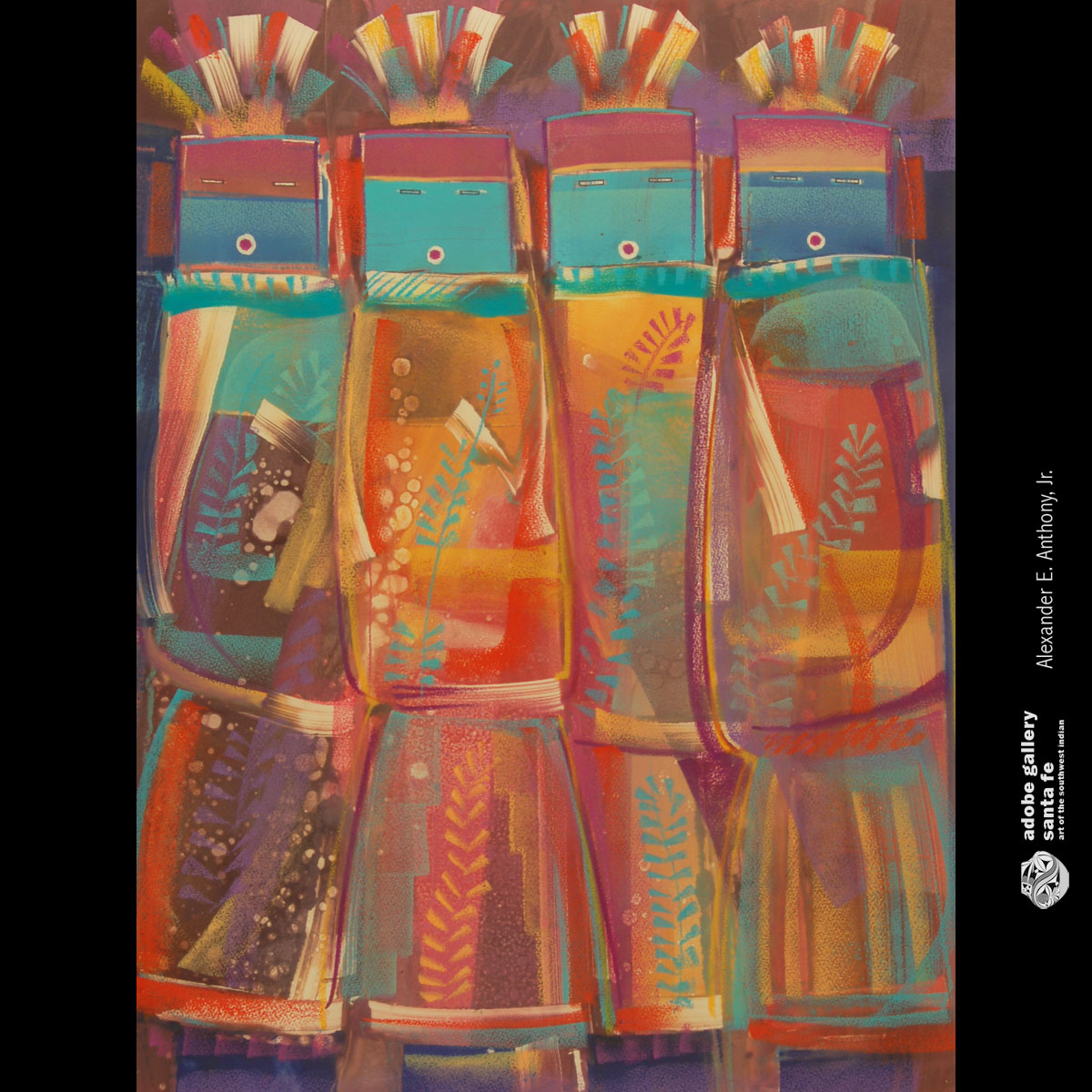 Navajo artist Tony Abeyta (1965- ) is one of the best and most collectible contemporary Native American painters. Abeyta was educated at Santa Fe's Institute of American Indian Arts, the Maryland Institute College of Art in Baltimore, and overseas in Italy and Southern France. He later returned to school, taking postgraduate classes in art and filmmaking at the Chicago Art Institute. Though best known for his unique landscapes and richly textured mixed media depictions of Navajo Yei figures, Abeyta works comfortably and successfully with a variety of media.
Navajo artist Tony Abeyta (1965- ) is one of the best and most collectible contemporary Native American painters. Abeyta was educated at Santa Fe's Institute of American Indian Arts, the Maryland Institute College of Art in Baltimore, and overseas in Italy and Southern France. He later returned to school, taking postgraduate classes in art and filmmaking at the Chicago Art Institute. Though best known for his unique landscapes and richly textured mixed media depictions of Navajo Yei figures, Abeyta works comfortably and successfully with a variety of media.
Monotype printmaking is one of the many areas in which Abeyta excels. Monotype printing is a method of printing in which an image is created on a smooth, non-absorbent surface (usually a copper, zinc, glass or acrylic plate) and then transferred to a sheet of paper by pressing the two together. The initial print is often augmented with additional paints or other materials, creating textures that are unique to the medium. Each monotype is, as the medium's name implies, unique-they are not produced in multiples.
To purchase or read more click here..
#adobegallery #SouthwestIndianPainting #NativeAmericanPainting #Navajo #PuebloPaintings #SantaFeNM #FineArt #Painting #TonyAbeyta
Navajo Sterling Silver Bracelet with Five Bands by Jonathan Mike - C4057C
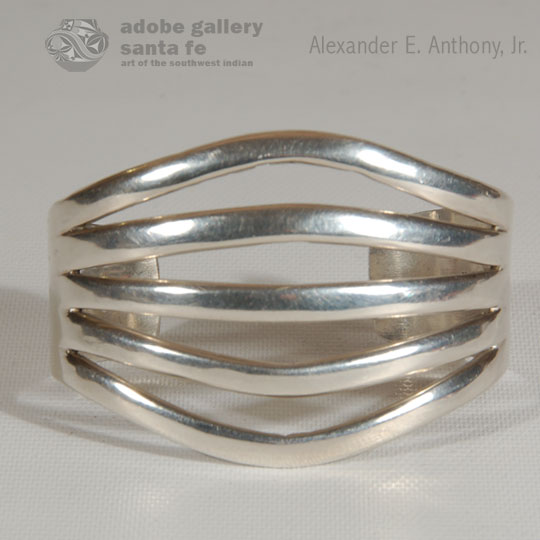 The elegant, modern style called "Navajo Modernism" had its roots at the White Hogan Gallery in Scottsdale, Arizona, beginning in the 1950s. The gallery was owned and operated by Virginia and John Bonnell. The Bonnells hired innovative artists like Kenneth Begay and Allen Kee who developed a unique look that was influenced by the work of Georg Jensen and Danish Modernism. Characterized by smooth, clean lines, the work had a sleek, sensuous appeal. The artists blended traditional Navajo designs into their work creating a distinctive look that continues to influence Navajo jewelers today. As the fabrication of jewelry associated with White Hogan Gallery required great skill, and only the very best artists worked at the White Hogan.
The elegant, modern style called "Navajo Modernism" had its roots at the White Hogan Gallery in Scottsdale, Arizona, beginning in the 1950s. The gallery was owned and operated by Virginia and John Bonnell. The Bonnells hired innovative artists like Kenneth Begay and Allen Kee who developed a unique look that was influenced by the work of Georg Jensen and Danish Modernism. Characterized by smooth, clean lines, the work had a sleek, sensuous appeal. The artists blended traditional Navajo designs into their work creating a distinctive look that continues to influence Navajo jewelers today. As the fabrication of jewelry associated with White Hogan Gallery required great skill, and only the very best artists worked at the White Hogan.
To purchase or read more click here..
#adobegallery #SouthwestIndianJewelry #Navajo #Diné #Silver #Jewelry #SantaFeNM #NavajoJewelry #SantaFeJewelry #JonathanMike
Miniature Navajo Yei Pictorial Rug - C4056J
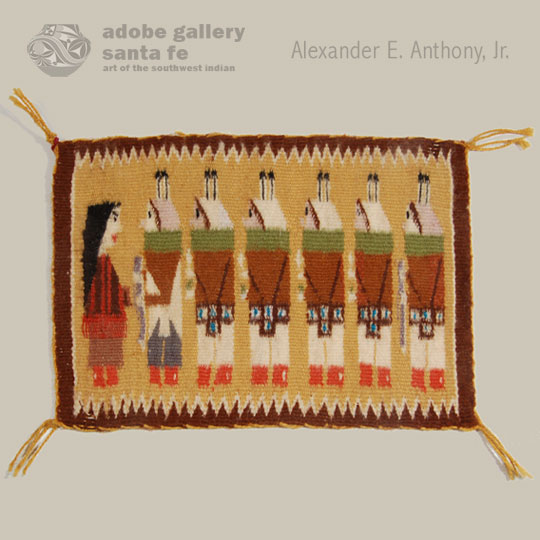 One of the finest weavers of miniature Navajo textiles, with whom we are familiar, is Louise Bia Yazzie (1953- ). We purchased miniature textiles from her for many years at the Albuquerque gallery, but have lost contact with her since we moved to Santa Fe. It is possible that this was woven by Louise, but we cannot be sure.
One of the finest weavers of miniature Navajo textiles, with whom we are familiar, is Louise Bia Yazzie (1953- ). We purchased miniature textiles from her for many years at the Albuquerque gallery, but have lost contact with her since we moved to Santa Fe. It is possible that this was woven by Louise, but we cannot be sure.
It is a pictorial textile featuring a line of Navajo Yei figures. Interestingly, the heads of the front and back Yei are slight violet color and their faces are white. The faces of the five in the middle have faint violet color and their heads are white. Subtle differences as these are what make one weaver stand apart from another.
To purchase or read more click here...
#adobegallery #SouthwestIndianTextiles #Navajo #Textiles #Blankets #Rugs #Diné #SantaFeNM #NavajoRugs #SantaFeRugs
Polychrome Hopi Pueblo Plate with Spiral Bird Design by Evelyn Poolheco - C4052E
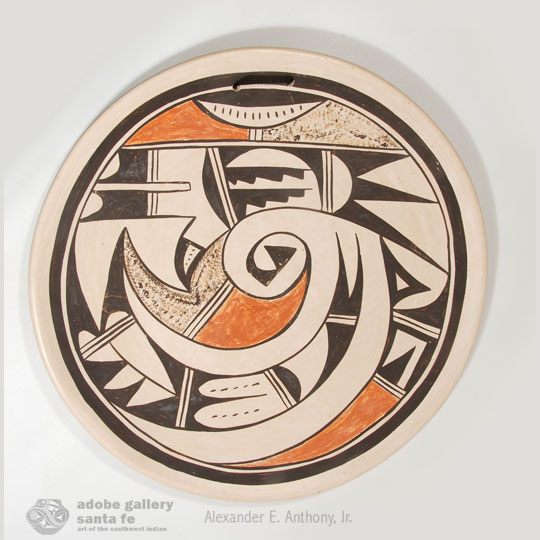 The Hopi have lived on three mesas in northeastern Arizona for more than 1,000 years. Today they live in 12 separate villages on or below the three Mesas. The Hopi language is part of the Uto-Aztecan language group, one of the largest Native American language groups. Tribes speaking Uto-Aztecan languages range geographically from the Shoshone of northern Idaho to the Pipil of El Salvador. On Hopi's First Mesa, a group of relative newcomers from the Rio Grande Tewa Pueblos speak the Tewa language.
The Hopi have lived on three mesas in northeastern Arizona for more than 1,000 years. Today they live in 12 separate villages on or below the three Mesas. The Hopi language is part of the Uto-Aztecan language group, one of the largest Native American language groups. Tribes speaking Uto-Aztecan languages range geographically from the Shoshone of northern Idaho to the Pipil of El Salvador. On Hopi's First Mesa, a group of relative newcomers from the Rio Grande Tewa Pueblos speak the Tewa language.
In the late 19th Century, Jesse Walter Fewkes led the Hemenway Expedition to the American Southwest to do anthropological studies of the Hopi and Zuni tribes. While there, he undertook the excavation of the ancient Hopi village of Sikyatki where he found a large number of ceramic wares. Sikyatki Polychrome was produced from about AD 1375 to AD 1625. Fewkes worked with potters on First Mesa to catalog the designs and record them. At that time there was a revival of using Sikyatki designs on Hopi pottery. The best-known potter who began to utilize the ancient designs was Nampeyo of Hano, but many other potters also began to incorporate the curvilinear bird and feather designs into their pottery. The revival of Sikyatki designs on Hopi pottery continues to this day.
To purchase or read more click here..
#adobegallery #SouthwestIndianPottery #HopiPueblo #PuebloPottery #SouthwestIndianArt #SantaFePottery #FinePuebloPottery #EvelynPoolheco



